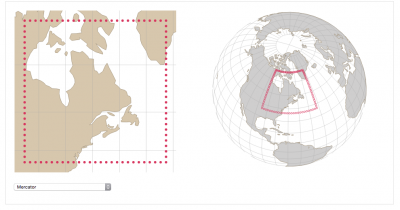Map distortion visualization tool
Whenever we try to represent our 3D earth on a 2D map we necessarily introduce distortion. This tool attempts to visualize the phenomenon.
Sports + Neuroscience = Brain Games
Can two entrepreneurs turn neuroscience into moneyball?
Mental analytics may be the next frontier in sports, and any number of companies has already set out exploring new ways to conquer it. Sherwin, 32, and Muraskin, 30, are younger and joined the party later than most of them. Neither had any background in business or baseball. Sherwin, who has floppy auburn hair and a scruffy beard, is the son of a conservative Chicago rabbi. Muraskin, more boyish-looking, with dark features and prominent eyebrows, is a skilled computer programmer. When they met, in the biomedical engineering department at Columbia University, Sherwin was studying the neural composition of cellists. Muraskin stumbled into neuroscience by researching Alzheimer’s and aging, and had been analyzing the efficiency of magnetic resonance imaging (MRI).
NASA releases free PDF of 1970s design manual in response to reissue campaign
“We can’t say the move is directly responding to our project, but it’s safe to suspect they are related. It’s great that they’re making the guidelines available to the public, we think they should be. That said, we don’t think that having an online PDF is the easiest way to engage with the information.”
See What Happened to the Venues of the 1980 Moscow Olympics
Russian photographer Anastasia Tsayder offers an illuminating case study in Summer Olympics, a series that revisits some of the venues the Soviet Union built for the ill-fated 1980 Summer Games in Moscow. “[I wanted] to tell a story about the hopes for a utopian future encapsulated in this architecture,” the photographer says, “and about how far from reality these expectations turned out to be in the end.”
What Refugees Bring When They Run for Their Lives
Few arrive at their destinations with anything but the necessities of life. The International Rescue Committeeasked a mother, a child, a teenager, a pharmacist, an artist, and a family of 31 to share the contents of their bags and show us what they managed to hold on to from their homes. Their possessions tell stories about their past and their hopes for the future.
Airport control towers without humans
Ornskoldsvik is the first airport in the world to use such technology.
Klencke Atlas from 1660 is 6 feet tall
A gift given to England’s Charles II in 1660, The Klencke Atlas featured state-of-the-art maps of the continents and various European states. It was also notable for its size. Standing six feet tall and six feet wide (when opened), the volume remains 355 years later the largest atlas in the world.

